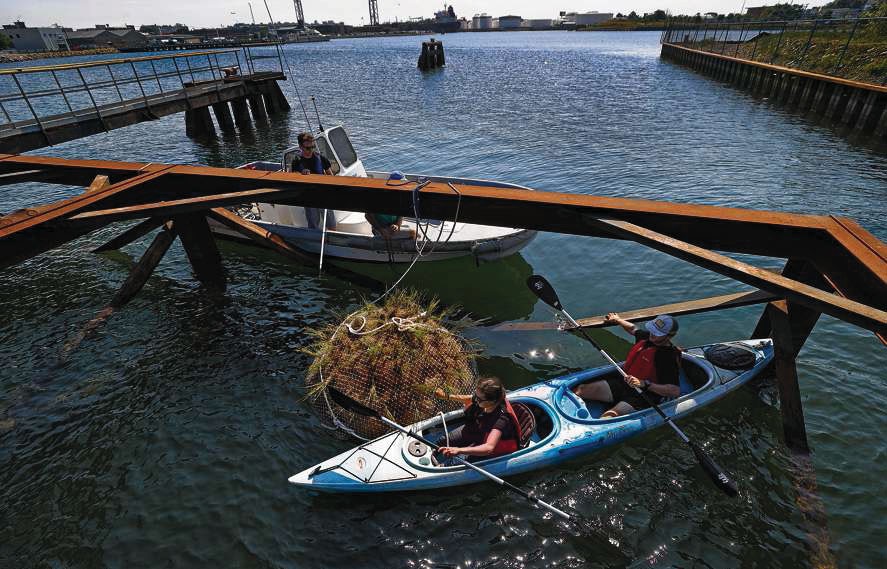
Boston’s Emerald Necklace, a swath of parks and arboretums, has provided much-needed greenery to a city with vast stretches of concrete. Now, a project led by researchers at Northeastern University might add another emerald garment to the city’s conservation efforts.
The “Emerald Tutu’’ is a proposed system of floating vegetation mats that, when interconnected, could protect Boston’s shoreline from rising sea levels and coastal flooding. The tutu could also serve as a cosmetic attraction to Boston Harbor.
According to the researchers, the tutu acts as a buffer between the shoreline and incoming waves. Each individual vegetation mat can absorb wave energy and protect approximately one foot of shoreline, a number that increases when the many mats that make up a tutu are interconnected.
“In the long term, I want to see thousands and thousands of these units deployed in the harbor and buffering the shoreline like a giant sponge from the intense climate-driven storms that are inevitably coming our way,’’ said Gabriel Cira, a Massachusetts licensed architect and project lead for the tutu.
The first steps toward Cira’s vision are underway, with an individual prototype being deployed in Chelsea Creek off of East Boston last Tuesday. It’s the second prototype to be deployed this year, with the first floating in waters near Salem.
Each individual unit of the tutu has a distinctive circular shape and is roughly seven feet in diameter, with marsh grasses decorating the floating tops and aquatic plants and seaweed attached to the submerged portion.
The units are made of biodegradable materials including recycled wood, burlap canvas, and coconut fiber. Each unit is held in place by a sequence of ropes designed to limit seafloor attachments. If a unit is dislodged and lost at sea, the system would decompose rather than contribute to pollution. Cira said building the tutu out of wood and other biodegradables makes the tutu a cost-effective solution compared to other alternatives.
“The prototypes that we’re building this year cost, like just the materials themselves, a few hundred dollars,’’ Cira said. “$280 to $300 each.’’
Julia Hopkins, an assistant professor of civil and environmental engineering at Northeastern and the coastal hydrology expert for the project, said that while the team hopes to deploy dozens of individual vegetation mats in Boston waterways next summer, they cannot succeed without communal support.
“The whole point is to make these things deployable – not just physically, you can put them into the water, and it works,’’ Hopkins said. “But deployable also means ‘will people want it there?’ If they don’t, then it’s not deployable.’’
The team is working to incorporate climate justice into the project’s plans, looking to earn support in communities where the issue of coastal flooding is most pressing.
With global sea levels expected to rise by an average of as much as 10 to 12 inches by 2050, lower-elevation neighborhoods such as East Boston and the Seaport are at risk of significant flooding in the coming decades. According to Cira, enabling climate justice in East Boston has been a goal for the tutu.
“There has been no environmental justice there to date – that’s the main reason,’’ Cira said. “You can see that they will be one of the first places in the Greater Boston area to have significant flooding inland during climate-related events, such as winter nor’easters.’’
East Boston now has its second prototype of the last 12 months. The first was deployed last summer near Piers Park, and project leaders were pleased to find large quantities of plants and seaweed that had attached to the mat, a key component in wave absorption.
John Macomber, a senior lecturer at Harvard Business School and professor of the course “Sustainable Cities and Resilient Infrastructure,’’ is cautiously enthusiastic about the feasibility of the tutu for at-risk communities.
“East Boston, or parts of Chelsea or parts of Mattapan, or as you get farther down the coast, and like Fall River... are much more exposed,’’ said Macomber. “So the idea of finding a natural solution that doesn’t require a bunch of real estate investment seems to make sense, to protect those populations.’’
Cira and Hopkins are founding members of the project, which started at MIT’s Climate Changed competition in 2018 where the initial idea earned first place. The tutu went on to receive the 2019 American Society of Civil Engineers innovation award in the sustainable engineering category. The team is still working to determine sources of funding for the project, and hopes to pay for future endeavors through grants and community support.
Part of the motivation behind the “Emerald Tutu’’ is developing an eco-friendly and cost-effective alternative to building concrete barriers in the harbor, a solution proposed in 2017 to curb future storm surges and protect the city’s coastline.
“I see our product as the sort of alternative to the wall solution, where it’s like, we know we need to change and adapt our neighborhoods little by little,’’ Cira said. “And we know we need to focus on the ecology and the health of the city.’’
As for the long-term future of the “Emerald Tutu,’’ Hopkins and the team have big goals – including expanding the project to urban shorelines across the country.
“I can design a bunch of different structures and systems that have a different connection, different sizes, different shoreline orientation,’’ she said, “which means we can put that around any shoreline that we have information for.’’
Collin Robisheaux can be reached at collin.robisheaux@globe.com. Follow him on Twitter @ColRobisheaux.

